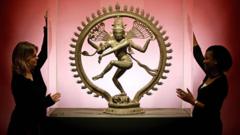In the 11th Century, southern India boasted immense accomplishments led by the Chola dynasty, particularly under King Rajaraja Chola. He undertook an awe-inspiring project, constructing the Brihadishvara temple, an architectural marvel standing 216 ft tall, completed in just a decade. This temple wasn't merely a place of worship; it symbolized the empire's vast wealth, decorated with a stunning 12-ft golden emblem of Shiva and countless pearls from conquered lands. The Cholas were innovators who reshaped their world.
Before rising to prominence, the Cholas were among various clashing factions in Tamil Nadu. They stood out for their political acumen and transformative influence, especially through significant female figures. Rajaraja's great-aunt, Sembiyan Mahadevi, played a vital role in the dynasty's public image, promoting the god Nataraja, a lesser-known form of Shiva, and solidifying the Cholas' connection to him.
Rajaraja Chola not only built temples but expanded his territory through strategic conquests, resulting in a flourishing empire. The Brihadishvara temple, for example, became a center for innovative public works, managing resources like 5,000 tonnes of rice annually.
The Chola dynasty became crucial players in the Indian Ocean trade, setting the stage for intricate relationships between rulers and merchants. Maharaja Rajendra, Rajaraja's successor, engaged in trade and military expeditions that transcended borders, leading Tamil merchants into Southeast Asia as early as the 11th Century.
These merchants established trade networks reaching as far as China, shaping economic and cultural ties that are still felt today. By the late 11th Century, these Tamil merchants had firm footholds in numerous regions, creating a multi-ethnic melting pot that fostered immense creativity in art and literature.
Chola bronze sculptures are now globally recognized, reflecting sophisticated craftsmanship comparable to that of Italy's Renaissance artists. The Cholas' significant contributions to architecture and trade made southern India a beacon of cultural sophistication in a time of relative global obscurity.
Their legacy highlights the profound impact a single dynasty can hold over historical narratives and serves as a reminder of the deep-seated connections between ancient civilizations.






















